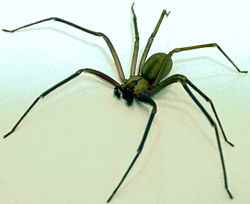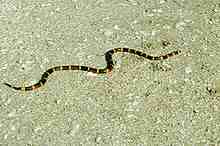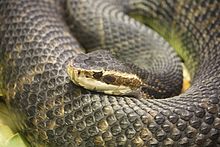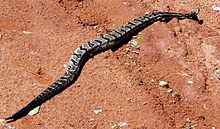DANGEROUS ANIMALS

You should also avoid large grazing animals with horns, hooves, and great weight. Your actions may prevent unexpected meetings. Move carefully through their environment. Do not leave food around your camp as that will attract predators. Carefully survey the scene before entering water or forests. Spotting them as soon as possible will give you the best options when it comes to avoiding them or eluding them.
Smaller animals actually are a bigger threat to you than large animals. These animals may be smaller but they are harder to see often have venomous bites or stings and there are just many more of them out there. Every year, a few people are bitten by sharks, mauled by alligators, and attacked by bears. Most of these incidents were in some way the victim's fault. However, each year more victims die from bites by relatively small venomous snakes than by large dangerous animals. Even more victims die from allergic reactions to bee stings.
Because of this this article will pay more attention to smaller and potentially more dangerous creatures. These are the animals you are most likely to encounter while try to survive by living off the land.
INSECTS AND ARACHNIDS
Prevention is the best medicine when it comes to dealing with insects. Check your footwear and clothing every morning. Also check your bedding and shelter for them. Use care when turning over rocks and logs. Things you used to do without thinking now you cannot afford to do.
Scorpions
Scorpions are insects with jointed tails with a stinger on the tip. You find scorpions in deserts, jungles, and forests of tropical, subtropical, and warm temperate areas of the world. They are mostly nocturnal. You can find desert scorpions from below sea level in Death Valley to elevations as high as 10,000 feet in the Andes. Scorpions are typically brown or black in wetter areas; they may be yellow or light green in the desert. Their average size is roughly 1 inch long. Fatalities from scorpion stings are rare, but they can occur in children, the elderly and ill persons.
Spiders


Centipedes and Millipedes
Centipedes and millipedes are mostly small and harmless, although some tropical and desert species may reach 10 inches (25cm). A few varieties of centipedes have a poisonous bite, but infection is the greatest danger, as their sharp claws dig in and puncture the skin. To prevent skin punctures, brush them off in the direction they are traveling, if you find them crawling on your skin.
We are all familiar with bees, wasps, and hornets. They come in many varieties and have a wide diversity of habits and habitats. Avoiding these creatures is the best tactic.
Be especially wary around large groups of flowering bushes and vines. Be careful of meat-eating yellow jackets when cleaning fish or game. The average person has a relatively minor and temporary reaction to bee stings and recovers in a couple of hours when the pain and headache go away. Those who are allergic to bee venom have severe reactions including anaphylactic shock, coma, and death. If antihistamine medicine is not available and you cannot find a substitute, an allergy sufferer in a survival situation is in danger of dying.
Ticks Ticks are common in the tropics and temperate regions. They are familiar to most of us. Ticks are small round arachnids with eight legs and can have either a soft or hard body. Ticks require a blood host to survive and reproduce. This makes them dangerous because they spread diseases like Lyme disease, Rocky Mountain spotted fever, encephalitis, and others that can ultimately be disabling or fatal. There is little you can do to treat these diseases once contracted.
Prevention is the key again. If you are living in the south you will invariably get ticks on you on a regular basis. It takes at least 6 hours of attachment before a tick can transmit any diseases to you. Thus every day if in tick territory you should give your body a thorough inspection for ticks.
LEECHES
Leeches are blood-sucking worm-like disgusting creatures. You find them in the tropics and in temperate zones. You will certainly encounter them when swimming in infested waters. A favorite feature in movies but in the USA they are not going to be a big problem for anyone. Exposure will likely be limited and a simple inspection after leaving the water will prevent any problems with them.
BATS
Despite the movies and the fear some have bats (Desmodus species) are a relatively small hazard not worth mentioning. Don't worry about bats in the USA.
There are no infallible rules for easy identification of poisonous snakes in the field, because the rules all require close observation or manipulation of the snake's body. The best strategy is to leave all snakes alone or kill from a safe distance and utilize them for food. Apply the following safety rules when traveling in areas where there are poisonous snakes:
Watch where you step. Step onto logs rather than over them.
Do not play with snakes, kill them or leave them.
Use sticks to turn logs and rocks.
Wear proper footgear, particularly at night.
Be calm when you encounter snakes, snakes cannot hear and you can occasionally surprise them when they are sleeping or sunning.
Normally, they will flee if given the opportunity.
Use extreme care if you must kill snakes for food or safety. Although it is not common, warm, sleeping human bodies occasionally attract rattlesnakes.
In the USA after killing a snake you can identify if it is poisonous by looking at the eye. If the pupil is round it is not poisonous. If the pupil is a vertical slit then it was venomous. Coral snakes are the exception but the black, red and yellow bands make them super easy to identify.
Coral snakes are not aggressive and or of little concern normally even though they have the most lethal venom.




DANGEROUS LIZARDS
The Gila monster and the Mexican beaded lizard are dangerous and poisonous lizards.
Gila Monster
The Gila monster (Heloderma suspectrum) of the American southwest, including Mexico, is a large lizard with dark, highly textured skin marked by pinkish mottling. It averages 12 to 15 inches (30-38cm) long and has a thick, stumpy tail. Unlikely to bite unless molested, it has a poisonous bite.
Turtle
Be careful when handling and capturing large freshwater turtles, such as the snapping turtles and soft-shelled turtles of North America. These turtles will bite in self-defense and can amputate fingers and toes and once latched on they will not normally let go. Cut off the head and pry the mouth open.
DANGERS IN BAYS AND ESTUARIES
In areas where seas and rivers come together, there are dangers associated with both fresh and saltwater. In shallow salt waters, there are many creatures that can inflict pain and cause infection to develop. Stepping on sea urchins, for example, can produce pain and infection. When moving about in shallow water, wear some form of footgear and shuffle your feet along the bottom, rather than picking up your feet and stepping.
Stingrays (Dasyatidae species) are a real hazard in shallow waters, especially tropical waters. The type of bottom appears to be irrelevant. There is a great variance between species, but all have a sharp spike in their tail that may be venomous and can cause extremely painful wounds if stepped on. All rays have a typical shape that resembles a kite. You find them along the coasts of the Americas, Africa, and Australasia.
SALTWATER DANGERS
There are several fish that you should not handle, touch, or contact. There are others that you should not eat. Several of the fish you should not handle or touch that are identified below.
Shark
Sharks are the most feared animal in the sea. Usually, shark attacks cannot be avoided and are considered accidents. You, as a survivor, should take every precaution to avoid any contact with sharks. There are many shark species, but in general, dangerous sharks have wide mouths and visible teeth, while relatively harmless ones have small mouths on the underside of their heads. However, any shark can inflict painful and often fatal injuries, either through bites or through abrasions from their rough skin.
Rabbitfish
Rabbitfish or spinefoot (Siganidae species) occur mainly on coral reefs in the Indian and Pacific oceans. They have very sharp, possibly venomous spines in their fins. Handle them with care, if at all. This fish, like many others of the dangerous fish in this section, is considered edible by native peoples where the fish are found, but deaths occur from careless handling. Seek other nonpoisonous fish to eat if at all possible.
Tang
Tang or surgeonfish (Acanthuridae species) average 20 to 25 centimeters in length and often are beautifully colored. They are called surgeonfish because of the scalpel-like spines located in the tail. The wounds inflicted by these spines can bring about death through infection, envenomation, and loss of blood, which may incidentally attract sharks.
Toadfish
Toadfish (Batrachoididae species) occur in tropical waters off the Gulf Coast of the United States and along both coasts of Central and South America. These dully colored fish average 18 to 25 centimeters in length. They typically bury themselves in the sand to await fish and other prey. They have sharp, very toxic spines along their backs.
Animals and Fish Poisonous to Eat
Survival manuals often mention that the livers of polar bears are toxic due to their high concentrations of vitamin A. For this reason, we mention the chance of death after eating this organ. Another toxic meat is the flesh of the hawksbill turtle. You recognize them by their down-turned bill and yellow polka dots on their neck and front flippers. They weigh more than 100 pounds (45kg) and are unlikely to be captured.
Many fish living in reefs near shore, or in lagoons and estuaries, are poisonous to eat, though some are only seasonally dangerous. The majority are tropical fish; however, be wary of eating any unidentifiable fish wherever you are. Some predatory fish, such as barracuda and snapper, may become toxic if the fish they feed on in shallow waters are poisonous. The most poisonous types appear to have parrot-like beaks and hard shell-like skins with spines and often can inflate their bodies like balloons. However, at certain times of the year, indigenous populations consider the puffer a delicacy.
Blowfish Blowfish aka puffers are found along tropical and temperate coasts, even in some of the rivers of Southeast Asia and Africa. Stout-bodied and round, many of these fish have short spines and can inflate themselves into a ball when alarmed or agitated. Their blood, liver, and gonads are so toxic that as little as 1 ounce can be fatal. These fish vary in color and size, growing up to 2 1/2 feet in length.
Triggerfish
The triggerfish (Balistidae species) occur in great variety, mostly in tropical seas. They are deep-bodied and compressed, resembling a seagoing pancake up to 60 centimeters in length, with large and sharp dorsal spines. Avoid them all, as many have poisonous flesh.
Barracuda
Although most people avoid them because of their ferocity, they occasionally eat barracuda (Sphyraena barracuda). These predators of mostly tropical seas can reach almost 5 feet in length and have attacked humans without provocation supposedly. I doubt that. They occasionally carry the poison ciguatera in their flesh so avoid eating them.
Other Dangerous Sea Creatures
Jellyfish
Jellyfish-related deaths are rare, but the sting they inflict is extremely painful. The Portuguese man-of-war resembles a large pink or purple balloon floating on the sea. It has poisonous tentacles hanging up to 25 feet or more below its body. The huge tentacles are actually colonies of stinging cells. Most known deaths from jellyfish are attributed to the man-of-war. Other jellyfish can inflict very painful stings as well. Avoid the long tentacles of any jellyfish, even those washed up on the beach and apparently dead.
